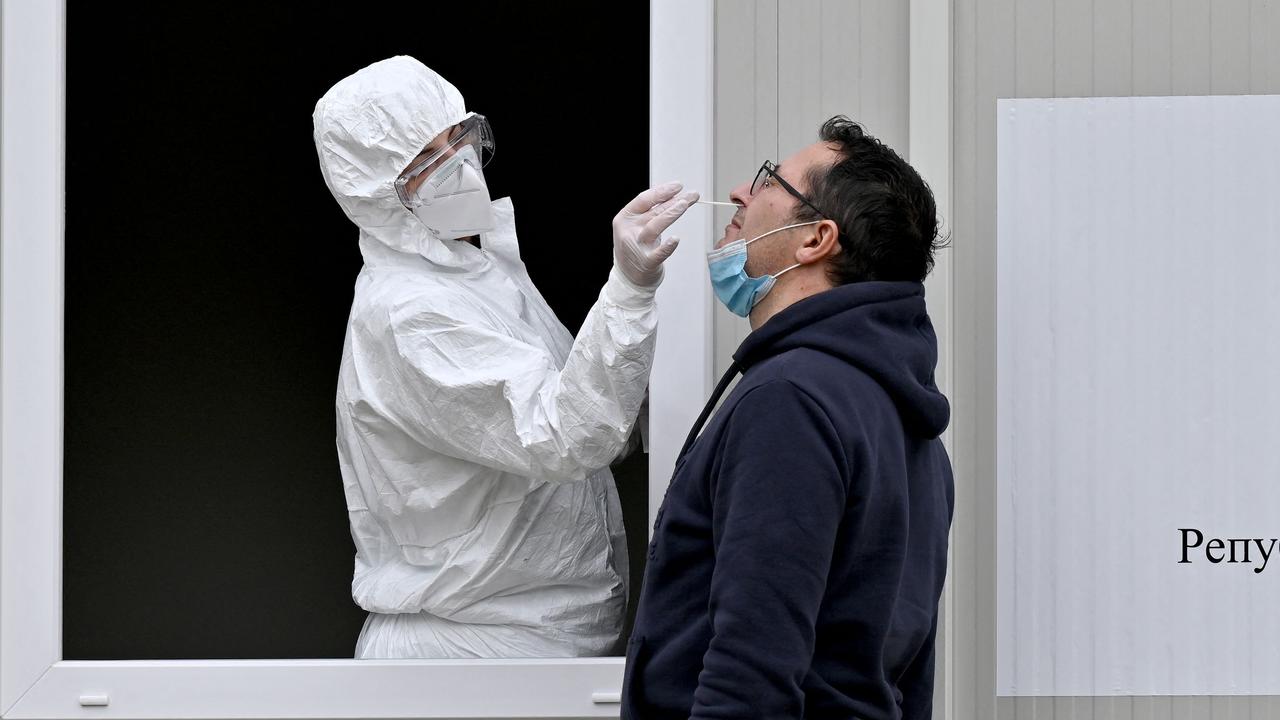Coronavirus Australia: Victoria announces border changes as NSW records three new local cases
Victorian Premier Daniel Andrews has introduced a new border permit system as NSW records three new local cases.
Coronavirus
Don't miss out on the headlines from Coronavirus. Followed categories will be added to My News.
Victoria will reopen its border to people from regional NSW from Monday night, Premier Daniel Andrews has announced.
Mr Andrews said from 5.59pm on Monday, regional NSW will become an ‘orange’ zone under Victoria’s new traffic light permit system for coronavirus risk.
People wanting to return to Victoria will need to apply for a permit before crossing the border or face “significant” fines.
“I’m pleased to say that regional NSW from 5.59pm tonight will become orange, will move out of the red zone and people from Victoria who want to travel home from those areas, you will be able to do so,” the Premier said.
Greater Sydney – including the Blue Mountains and Wollongong – remains in the red zone, as does Brisbane.
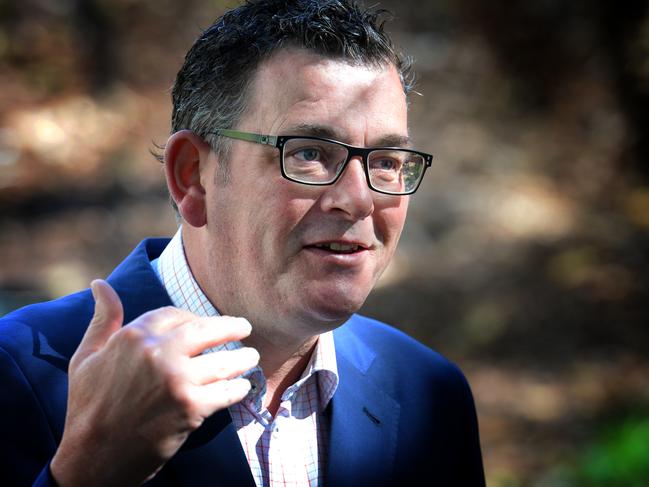
“Greater Sydney remains red and we will update that daily … the public health team will provide advice at the appropriate time and that can become orange and green at some point in the future,” he said.
“In terms of Brisbane, while the restrictions that have been imposed for greater Brisbane come off at 6pm tonight, the public health team is not 100 per cent confident we can have people from Brisbane returned to Victoria.
“Again that will be updated daily, late in the week hope to have more to say about Sydney, and Brisbane, I want to thank all of those people who are very patiently waiting, until the public health advice allows us to have those people return home.
“We know this is deeply inconvenient and challenging time for you, but there is no alternative but to follow the best public health advice and make sure we do nothing – any of us – do nothing to jeopardise the precious thing we have built here.”
Under the new permit system, people arriving from orange zones will need to take a coronavirus test within 72 hours after coming into Victoria, isolating both before and after their test and until they receive a negative result.
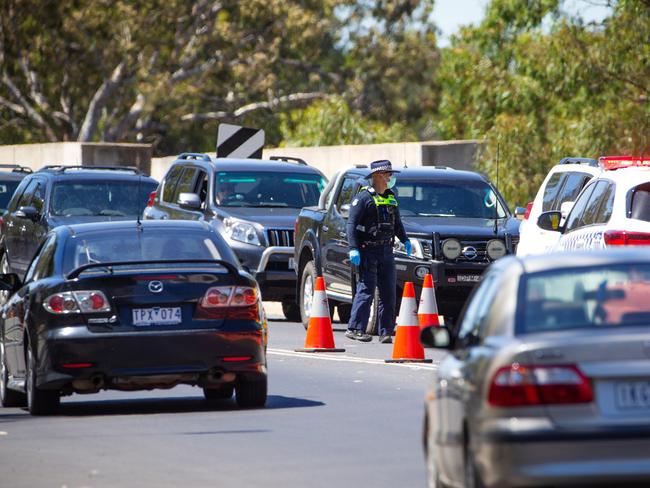
People from green zones will be able to enter the state once a permit has been obtained and don’t need to take a test.
If you have been in a red zone in the last 14 days, you will be turned back at the border.
Anyone who breaks the new rules faces a fine of $5000, although Mr Andrews said he hoped Victoria Police - who will still be patrolling the road border - would not have to issue any penalties.
Returned Victorian travellers arriving by plane or by water without a valid reason or exemption will be required to self-isolate at home for 14 days and will receive a fine of $4,957.

Professor Brett Sutton, the Victorian chief health officer, said the application process for a permit through the Service Victoria website should take only “a matter of minutes”.
“There is there‘s always a demand right at the beginning and people need to bear that in mind and have patience with the system, but this is a system that is going to be entered into for the long haul and it will be a very efficient system going forward … it will be very agile,” he said.
Professor Sutton said the decision to remove regional NSW from the red zone list came after potential outbreaks in areas such as the Central Coast, Broken Hill and Bermagui did not eventuate.
“They are all positives for regional NSW and that’s why it is going to have a determination of being an orange zone from 5:59pm tonight. In terms of Greater Sydney, the trend is positive, but there are ongoing cases, ongoing new exposure sites, ongoing transmission for the Greater Sydney area,” he said.
“Greater Sydney including Blue Mountains and Wollongong, will remain as red zones for now. There will be an ongoing review of Greater Sydney, in terms of mystery cases, ongoing transmission, the level and extent of exposure sites, and the chains of transmission.
“It is being referred to as a mop up exercise and the trend has been going down in terms of new cases every day that‘s a positive but the risk is still there. The designation of it as a red zone is appropriate in my view for now.”
He also said it was too soon to remove Brisbane from the red zone, as a hotel quarantine worker who tested positive for the virus was “out and about” in the community up until January 7.
It comes as Victoria recorded zero new locally acquired cases of coronavirus as more than 18,000 people were tested in the past 24 hours.
The Department of Health and Human Services also revealed one new infection in returned overseas travellers in hotel quarantine.
There are 40 active cases of COVID-19 across the state. There were 18,660 tests undertaken in the past 24 hours.
The number of active cases linked to the Black Rock Thai restaurant cluster remains at 27.
The number of people in isolation in Victoria because they are either positive cases or primary close contacts of cases stands at 2460.
There are now more than 200 testing centres in operation in Victoria, including a new testing site near gate one at the MCG.
Almost 200,000 tests have been taken in Victoria since the start of the year.
NEW RULES AS BRISBANE ENDS LOCKDOWN
Greater Brisbane will be released from lockdown on Monday night, but tight restrictions will stay in place for the next 10 days.
Queensland recorded no new locally acquired COVID-19 cases on Monday out of 18,904 tests, prompting the state’s premier and chief health officer to wind back movement restrictions from 6pm.
The city’s 2.5 million residents spent the weekend in lockdown while authorities raced to test and isolate anyone who came in contact with a hotel quarantine cleaner who contracted the highly contagious UK variant of COVID-19.
Annastacia Palaszczuk thanked Queenslanders for their “remarkable effort” over the weekend but said until at least January 22, Brisbane residents will continue to be required to wear a mask.
“We want to make sure that the incubation period, that 14 days, has totally lapsed before we return to normal,” Ms Palaszczuk said.

Residents of Brisbane, Ipswich, Logan, Moreton Bay and Redlands council areas will need to carry a face mask with them “at all times” until 1am on January 22.
“You will need to wear your mask in shopping centres, supermarkets, retail outlets and indoor markets,” Ms Palaszczuk said.
“In hospitals and aged care facilities, in churches and places of worship, libraries and at indoor recreational facilities such as cinemas, art galleries and gyms.”
Masks will also be required in indoor workplaces where workers cannot socially distance, as well as on public transport, and in taxis and ride shares.
Masks will no longer be required in private vehicles, and will not need to be worn while eating or drinking in restaurants or cafes, however front-of-house hospitality workers will continue to need to mask up.
“When in doubt, wear a mask, that is very simple,” Ms Palaszczuk said.
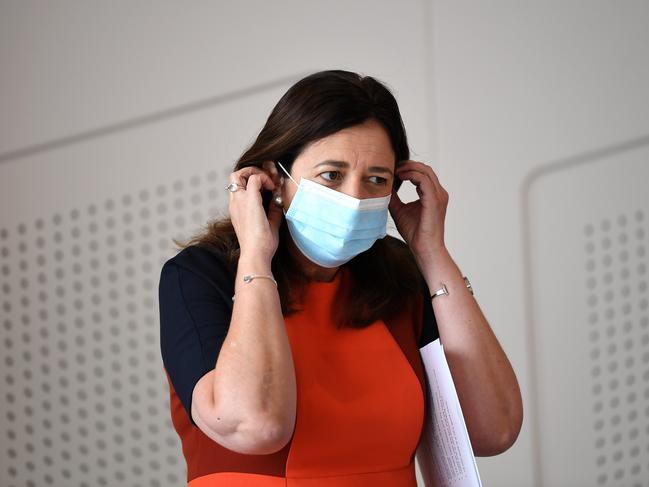
In addition, indoor hospitality and retail spaces will go back to the one-per-four square metre rule while one-per-two square metres will continue outdoors.
No dancing will be allowed except for at weddings, and patrons will only be able to eat or drink in hospitality venues while sitting.
“It is only for ten days and then hopefully, if we get zero community transmission over those ten days, then we can just go back to (being the same as) the rest of Queensland,” Ms Palaszczuk said
Up to 20 people will be allowed to gather inside a private residence until January 22.
Weddings and funerals will be restricted to 100 people, and outdoor stadiums will be allowed to operate at 50 per cent capacity.
At least 370 close contacts of the cleaner have been identified, 154 of which have so far tested negative.
It’s hoped restrictions on aged care homes, hospitals, disability accommodation and prisons will be eased on January 22 as well.
Queensland’s chief health officer Dr Jeannette Young said it was important to take a slow and steady approach to coming out of lockdown.
“The pandemic is still with us,” she said.
“We have achieved so much this past weekend. It’s important we come out of it carefully and sensibly.”
Since 6pm on Friday, residents had only been allowed to leave their home for four reasons, and had to wear a mask anytime they stepped outside their home.
Four cases of coronavirus were detected in returned travellers in hotel quarantine.
In another major development, travellers from Brisbane will be allowed to return to the Northern Territory as of Monday morning after the city’s hotspot status was revoked.
As of 11am, residents from Brisbane, Ipswich, Logan, Moreton Bay and Redlands council areas are able to enter the NT.
COVID SCARE AT NSW HOSPITAL
NSW officially recorded three new cases of coronavirus overnight, as well as two others after the daily cut-off.
Of the new cases, three are directly linked to the Berala cluster. A fourth case, a person who presented to the emergency department of Mount Druitt Hospital in western Sydney, was reported after the 8pm cut-off and will be included in Tuesday’s numbers.
Their household contact has also tested positive.
NSW Premier Gladys Berejiklian said the case remained under investigation.
“There’s no direct link at this stage,” she said.
Chief health officer Dr Kerry Chant said the person had presented at emergency with COVID-19 symptoms on Saturday before returning a positive result on Sunday night.

The emergency department is closed and doctors and nurses have been stationed outside in case anyone turns up for urgent treatment.
Current patients are being diverted to other hospitals, and doctors are being urged to refer people to Blacktown Hospital instead.
“The risk assessment is currently being evaluated. As you know, we take a very precautionary role given the importance of healthcare workers being COVID-free and also the fact that emergency departments have a lot of vulnerable people attend with underlying health conditions,” Dr Chant said.
She agreed it was concerning when any patients or staff were exposed.
NSW recorded three new locally acquired cases of COVID-19 in the 24 hours to 8pm last night.
— NSW Health (@NSWHealth) January 11, 2021
Eight cases were also recorded in returned travellers, bringing the total number of COVID-19 cases in NSW since the beginning of the pandemic to 4,829. pic.twitter.com/JTHfvEUvOj
Health officials will now working to determine the movements of any employees and other patients to determine whether they will be required to isolate and get tested.
Dr Chant was not able to confirm whether or not the patient was wearing a mask when they presented at the hospital.
“The general approach would be that patients are asked to wear masks. Some patients with respiratory symptoms or when they're very unwell aren’t able to tolerate a mask and so it is a clinical decision.”
VACCINE ROLLOUT ‘WON’T END RESTRICTIONS’
The COVID-19 vaccine rollout will not signal the end of restrictions with it likely to be months before Australia gets to see what a new normal looks like, the nation’s leading medical officer has warned.
Chief medical officer Paul Kelly said on Sunday it would likely to be the second half of the year before federal and state governments started to ease health and border restrictions.
However, persistent messaging about social distancing, coughing into your elbow, washing your hands, and home if you’re unwell will remain in place, he said.
“Every single person that gets their two doses of vaccine and gets that very strong protection against severe illness, will give people more confidence.
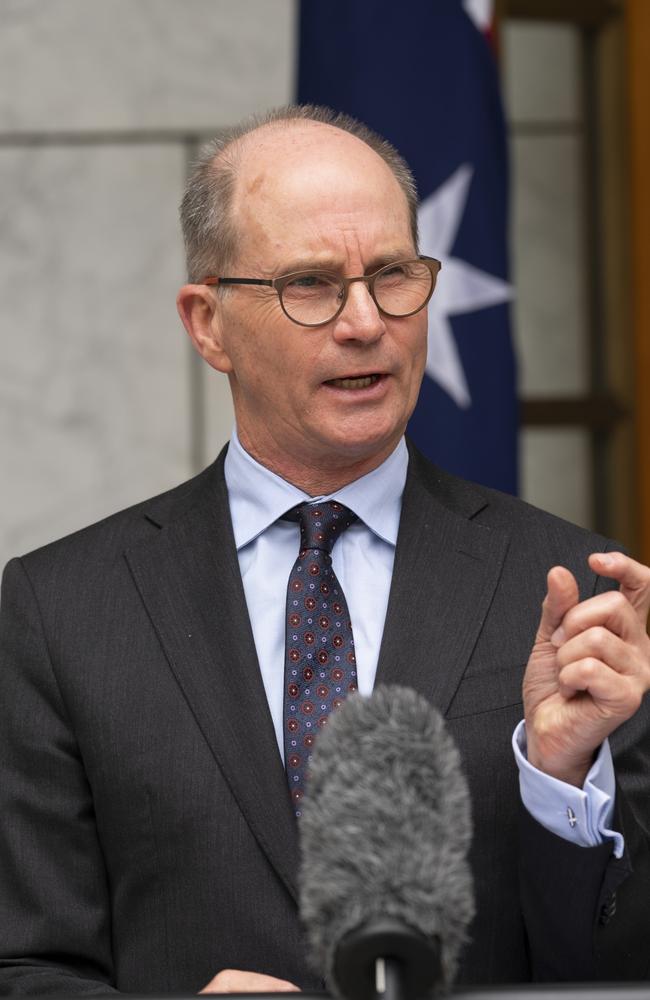
“It will give the public health system more confidence, will give our politicians — that need to make these decisions in the end — more confidence, about what a COVID-safe normal might look like in the second half of this year.”
Australia’s coronavirus vaccine rollout will begin next month.
First in line to be inoculated will be workers who have the highest exposure to COVID-19 including those working in hotel quarantine, transporting international arrivals, and health professionals.
“First priority is those that are at higher risk of exposure to the virus,” Professor Kelly said.
“That is the people that are working at our borders; the people working at our quarantine hotels; the nurses and other health professionals that are working in those settings; the cleaners; the transport workers that are transporting people to our quarantine hotels.
“They are the ones that are at highest risk of exposure so we need to get that vaccination out to them quickly.
“Same with our healthcare workers that are working at our hospitals and other frontline areas.”
He said Australia was fortunate when it came to the impacts of coronavirus — with more than 89 million cases worldwide that caused more than almost two million deaths.
There has not been a death of someone acutely sick with COVID-19 since October and there are just 41 people in hospital, he said.
“In the last 24 hours, we’ve had 13 cases — three of those, all in NSW, are locally acquired,” Professor Kelly said.
NSW
Visitors or residents of NSW who have been to Brisbane will be made to self-isolate, officials have announced.
The move came after Queensland announced a three-day lockdown of Brisbane, which will begin at 6pm Friday.
NSW will make anyone who has been in Brisbane, Logan, Ipswich, Moreton Bay, and Redlands from January 2 self-isolate.
FACE MASKS
A $200 on the spot fine will apply if you do not comply with the requirements to wear a face mask.
Children aged 12 and under are exempt but are encouraged to wear masks where practicable.
Places where face masks must be worn
You must wear a face mask indoors when you enter or work at
*retail or business premises that provides goods or services to the public including
*supermarkets
*shopping centres
*banks
*post offices
*hairdressers.
*residential aged care facilities (visitors, not residents).
Premises that are used for the purpose of providing health services are not retail premises or business premises.
Face masks are also mandatory when you are using public transport or are a passenger in a taxi or rideshare vehicle when you are waiting at a public transport waiting area (such as a bus stop, train platform or taxi rank) for all staff in hospitality venues and casinos for patrons using gaming services.
SOUTH AUSTRALIA
From midnight Friday January 8, anyone coming into SA from greater Brisbane will be required to quarantine for 14 days.
SA Premier Steven Marshall announced a hard border closure to NSW on January 1.
He said there will be few exemptions for those returning after 12.01am on Friday, but SA residents, people permanently moving states and essential travellers will be permitted.
All those groups will still need to self-isolate for 14 days.
Travellers returning to the state will need to demonstrate they met the criteria upon crossing the border.
He said people travelling from Queensland to South Australia must follow the most direct route through NSW and not spend “unnecessary time” interstate.
Mr Marshall said a 100km buffer zone will be implemented for cross-border communities, allowing people in Broken Hill and Wentworth to freely enter the state.
“We’re also going to be putting some transit allowances because there are people travelling through NSW who won’t be stopping,” Mr Marshall said.
Mr Marshall said border arrangements with Victoria would not change.
VICTORIA
Victoria’s border with NSW is now shut.
Any Victorian arriving from NSW before the deadline needed to get tested and quarantine for 14 days, the state government said.
On Wednesday, Victoria announced anyone who has been in the NSW regions of the Blue Mountains and Wollongong since Sunday had to return by 11.59pm on December 31.
The border was already closed to those in Greater Sydney and the Central Coast.
Victoria has also closed its borders to travellers from the Greater Brisbane area.
NORTHERN TERRITORY
The NT declared Greater Metropolitan Sydney a COVID-19 hotspot from midnight on New Year’s Eve, meaning anyone travelling from there must enter quarantine.
The NT had previously declared only seven Sydney suburbs hot spots.
QUEENSLAND
Queensland, which had already declared Greater Sydney a hotspot, is assessing the situation as it unfolds.
Chief health officer Dr Jeannette Young said on Thursday she was closely monitoring the New South Wales cluster and the new Victorian cases.
“I’m urging Queenslanders travelling to these states to reassess their plans – if it is not necessary, then consider staying here,” she said.
“The next 24 hours are critical for Victoria and the NSW cluster is growing daily. Queensland is in a good position right now because we acted quickly to declare greater Sydney a hotspot.”
WESTERN AUSTRALIA
Western Australia has introduced a hard border with Queensland, which will take effect from midnight on Friday, January 8.
Western Australia has already shut its border to NSW travellers but on Thursday said it will close to Victorian travellers too.
From 12.01am on January 1, only exempt Victorian travellers will be allowed into WA, while returning residents must self-isolate for two weeks.
Anyone who arrived in WA from Victoria on or after December 21 must also self-quarantine for 14 days.
TASMANIA
Tasmania has declared nine Victorian sites as high-risk COVID-19 areas including restaurants, clubs, churches, shopping centres, hotels, and bars.
People in Tasmania who have visited are asked to self-isolate and contact the public health line on 1800 671 738.
Non-Tasmanians who have been in the areas in the specified times cannot enter Tasmania without an exemption.
It has measures in place requiring travellers from Greater Sydney to quarantine.
More details on travel alerts here.
AUSTRALIAN CAPITAL TERRITORY
Non-ACT residents are banned from entering the territory if they have travelled from hot spots, unless granted an exemption. That means all nonresidents who have been in Greater Sydney, the Central Coast or Wollongong local government areas will be refused entry at the border.
ACT residents have to sign an online declaration form before returning then quarantine for 14 days.
– with Zoe Smith, Shoba Rao, and NCA NewsWire
Originally published as Coronavirus Australia: Victoria announces border changes as NSW records three new local cases

